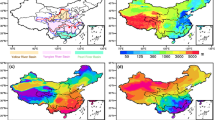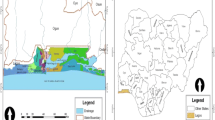Abstract
This study defines the Changma onset using the available water resources index (AWRI) for 25 years (1985–2009) and verifies the validity of this definition. The three conditions for defining the Changma onset are established as follows: (i) The first day exceeding the June AWRI (threshold) averaged over the 25-year period. (ii) The continuation of the value over the threshold for at least 1 week after the onset. (iii) After the continuation of more than 1 week, the non-continuation of the value under the threshold for at least 1 week. The 25-year average Changma onset date is 24 June with a standard deviation of 9 days. The defined Changma onset is verified through the analysis on the relationship with the Antarctic oscillation (AAO). AAO in June shows a high correlation with not only the Changma onset but also the June precipitation (AWRI) in Korea. These three variables are influenced by Mascarene and Australian (positive AAO pattern) highs from in the preceding March. When these two pressure systems develop, the cold cross-equatorial flow in the direction from the region around Australia to the equator is intensified, which in turn, forces a western North Pacific high (WNPH) to develop northward; this eventually drives the rain belt north. As a result, the Changma begins early in the positive AAO phase, and the June precipitation increases in Korea. In addition, a WNPH that develops more northward increases the landfalling frequency of tropical cyclones in Korea, which plays an important role in increasing the June precipitation.













Similar content being viewed by others
References
Byun HR, Lee DK (2002) Defining three rainy seasons and hydrological summer monsoon in Korea using available water resources index. J Meteorl Soc Jpn 80:33–44
Byun HR, Lee DK, Joung CH (1992) A study on the atmospheric circulation during the Dry Period before the Changma. Part I: existence and characteristics. Asia-Pacific J Atoms Sci 28:71–88 (In Korean with English abstract)
Chang HJ, Kwon WT (2007) Spatial variations of summer precipitation trends in South Korea, 1973–2005. Environ Res Lett 2:045012
Chang CP, Zhang Y, Li T (2000) Interannual and interdecadal variations of the East Asian summer monsoon and tropical Pacific SSTs. Part I: roles of the subtropical ridge. J Clim 13:4310–4325
Choi YJ (2004) Trends on temperature and precipitation extreme events in Korea. J Korean Geogr Soc 39:711–721 (In Korean)
Choi KS, Byun HR (2007) Definition of the onset and withdrawal of the Warm Season over East Asia and their Characteristics. Asia-Pacific J Atmos Sci 43:143–159
Ding YH (1992) Summer monsoon rainfalls in China. J Meteorol Soc Jpn 70:373–396
Fan K (2006) Atmospheric circulation in Southern Hemisphere and summer rainfall over Yangtze River valley. Chin J Geophys 49:672–679
Fan K, Wang HJ (2004) Antarctic oscillation and the dust weather frequency in North China. Geophys Res Lett 31. doi:10.1029/2004GL019465
Gao H, Xue F, Wang HJ (2003) Influence of interannual variability of Antarctic oscillation on Mei-yu along the Yangtze and Huaihe River valley and its importance to prediction. Chin Sci Bull 48:61–67
Gong DY, Ho CH (2003) Arctic oscillation signals in the East Asian summer monsoon. J Geophys Res 108(D2). doi:10.1029/2002JD002193
Gong DY, Wang SW (1999) Definition of antarctic oscillation index. Geophys Res Lett 26:459–462
Ha KJ, Yun KS, Jhun JG, Park CK (2005) Definition of Onset/Retreat and Intensity of Changma during the Boreal Summer Monsoon Season. Asia-Pacific J Atmos Sci 41:927–942 (In Korean with English abstract)
Hall A, Visbeck M (2002) Synchronous variability in the Southern Hemisphere atmosphere, sea ice, and ocean resulting from the annular mode. J Clim 15:3043–3057
Hendon H, Liebmann B (1990) A composite study of onset of the Australian summer monsoon. J Atmos Sci 47:2227–2240
Hendon HH, Thompson DWJ, Wheeler MC (2007) Australian rainfall and surface temperature variations associated with the Southern Hemisphere annular mode. J Clim 20:2452–2467
Ho CH, Kim JH, Kim HS, Sui CH, Gong DY (2005) Possible influence of the Antarctic Oscillation on tropical cyclone activity in the western North Pacific. J Geophys Res 110(D19104). doi:10.1029/2005JD005766
Huang RH, Wu YF (1989) The influence of ENSO on the summer climate change in China and its mechanism. Adv Atmos Sci 6:21–32
Inoue T, Matsumoto J (2003) Seasonal and secular variations of sunshine duration and natural seasons in Japan. Int J Climatol 23:1219–1234
Inoue T, Matsumoto J (2007) Abrupt Climate Changes Observed in Late August over Central Japan between 1983 and 1984. J Clim 20:4957–4967
Ju JH, Lu JM, Cao J, Ren JH (2005) Possible impacts of the arctic oscillation on the interdecadal variation of summer monsoon rainfall in East Asia. Adv Atmos Sci 22:39–48
Kalnay E et al (1996) The NCEP/NCAR 40-year reanalysis project. Bull Am Meteorol Soc 77:437–471
Kidson JW (1988) Interannual variations in the Southern Hemisphere circulation. J Clim 1:1177–1198
Kim KM (1979) A study on the rainfall characteristics of the rainy season in Korea. Asia-Pacific J Atmos Sci 15:55–70 (In Korean with English abstract)
Kim JW, Lee JG (2007) A qualitative analysis of WRF simulation results of typhoon ‘Rusa’ case. Atmosphere 17:393–405 (In Korean with English abstract)
Kim SS, Park SU, Lee BS (1983) The characteristics structural differences of the rainy front (Changma front) between the wet and dry seasons. Asia-Pacific J Atmos Sci 19:12–32 (In Korean with English abstract)
Kistler R et al (2001) The NCEP/NCAR 50-year reanalysis. Bull Am Meteorol Soc 82:247–267
Korea Meteorological Administration (1996) Changma white book. Korea Meteorological Administration, p 233
Krishnamurti TN, Bhalme HN (1976) Oscillation of a monsoon system, part I: observational aspects. J Atmos Sci 33:1937–1954
Kwok R, Comiso JC (2002) Spatial patterns of variability in Antarctic surface temperature: connections to the Southern Hemisphere Annular Mode and the Southern Oscillation. Geophys Res Lett 29. doi:10.1029/2002GL015415
Lau KM, Li MT (1984) The monsoon of East Asia and its global associations. Bull Am Meteorol Soc 65:114–125
Lau KM, Yang GJ, Shen SH (1988) Seasonal and intraseasonal climatology of summer monsoon rainfall over East Asia. Mon Weather Rev 116:18–37
Liang XZ, Wang WC (1998) Association between China monsoon rainfall and tropospheric jets. Q J R Meteorol Soc 124:2597–2623
Liebmann B, Smith CA (1996) Description of a complete (interpolated) outgoing longwave radiation dataset. Bull Am Meteorol Soc 77:1275–1277
Ramaswamy C, Pareek RS (1978) The southwest monsoon over Indian and its teleconnections with the middle and upper tropospheric flow patterns over the Southern Hemisphere. Tellus 30:126–135
Reason CJC, Rouault M (2005) Links between the Antarctic Oscillation and winter rainfall over western South Africa. Geophys Res Lett 32. doi:10.1029/2005GL022419
Rodwell MJ (1997) Breaks in the Asian monsoon: the influence of Southern Hemisphere weather systems. J Atmos Sci 54:2597–2611. doi:10.1029/2005GL022419
Sato N, Takahashi M (2001) Long-term variations of the Baiu frontal zone and midsummer weather in Japan. J Meteorl Soc Jpn 79:759–770
Seo KH, Lee DK (1996) Analysis and simulation of orographic rain in the middle part of the Korean Peninsula. Asia-Pacific J Atmos Sci 32:511–533 (In Korean with English abstract)
Silvestri GE, Vera CS (2003) Antarctic Oscillation signal on precipitation anomalies over southeastern South America. Geophys Res Lett 30: doi:10.1029/2003GL018277
Sun JQ, Wang HJ, Yuan W (2009) A possible mechanism for the co-variability of the boreal spring Antarctic Oscillation and the Yangtze River valley summer rainfall. Int J Climatol 29:1276–1284
Tao SY, Chen L (1987) A review of recent research on the East Asian summer monsoon in China. In: Chang C-P, Krishnamurti TN (eds) Monsoon Meteorology. Oxford University Press, Oxford, pp 60–92
Tao SY, He SX, Yang ZF (1983) An observational study on the onset of the summer monsoon over eastern Asia in 1979. Sci Atmos Sin 7:347–355 (in Chinese)
Thompson DWJ, Wallace JM (2000) Annular modes in the extratropical circulation, part I: month-to-month variability. J Clim 13:1000–1016
Wang HJ, Fan K (2005) Central-north China precipitation as reconstructed from the Qing dynasty: Signal of the Antarctic atmospheric oscillation. Geophys Res Lett 32. doi:10.1029/2005GL024562
Wang HJ, Fan K (2007) Relationship between the Antarctic oscillation and the western North Pacific typhoon frequency. Chin Sci Bull 52:561–565
Wang B, Lin Ho (2002) Rainy season of the Asian-Pacific summer monsoon. J Clim 15:386–398
Wang B, Lin Ho, Zhang YS, Lu MM (2004) Definition of South China Sea monsoon onset and commencement of the East Asia summer monsoon. J Clim 17:699–710
Xie P, Arkin PA (1997) Global precipitation: a 17-year monthly analysis based on gauge observation, satellite estimates, and numerical model outputs. Bull Am Meteorol Soc 78:2539–2558
Xue F, Wang HJ, He JH (2004) Interannual variability of Mascarene high and Australian high and their influences on East Asian Summer Monsoon. J Meteorol Soc Jpn 82:1173–1186
Yeh DZ, Tao SY, Li MC (1959) The abrupt change of circulation over the northern hemisphere during June and October. In: Bolin B (ed) The atmosphere and the sea in motion. Rockefeller Institute Press, New York, pp 249–267
Acknowledgments
We would like to thank anonymous reviewers for their constructive and critical comments.
Author information
Authors and Affiliations
Corresponding author
Rights and permissions
About this article
Cite this article
Choi, KS., Wang, B. & Kim, DW. Changma onset definition in Korea using the available water resources index and its relation to the Antarctic oscillation. Clim Dyn 38, 547–562 (2012). https://doi.org/10.1007/s00382-010-0957-1
Received:
Accepted:
Published:
Issue Date:
DOI: https://doi.org/10.1007/s00382-010-0957-1




